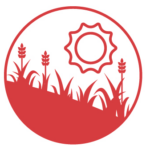For more on the why behind CLC, link to the “making the case for CLC” section of our website.
Annual row crops in the Upper Midwest leave the ground mostly bare for two-thirds of the year and have replaced native prairies and woodlands that, until the mid-1800s, covered the land all year, supported diverse wildlife, and built rich soils. Below ground the more transient roots of crops that grow during a single season have replaced the naturally deep, dense mesh of perennial roots. These changes allow large volumes of soil and nutrients – valuable farm inputs – to wash into lakes and streams and contaminate groundwater, damaging aquatic ecosystems and threatening human health. Soil health is reduced and native plant and animal habitat is lost, including critically important pollinators. Our diminished land and water resources are increasingly vulnerable to weather extremes.
Continuous Living Cover farming addresses issues inherent to our current agricultural system, which is bolstered by well-established supply chains, policies, and dominant agricultural narratives supporting a small number of crops. These issues include:
- Intense production of a few crops on many acres;
- Constrained economic opportunities;
- Negative environmental impacts.
With CLC, farmland stays in production, making good, year-round use of soil, nutrients, water, and solar resources. CLC farming introduces a greater diversity of crops and livestock. Water quality improves; stream flow is moderated; soil health improves and is sustained. Native wildlife species have more suitable habitat. New economic opportunities can develop for farmers and their communities. With CLC practiced widely, we contend that our land, water, farms, and communities will be more environmentally and economically resilient.
There are many types of CLC crops and systems and many ways they can be combined to meet the interests of farmers and landowners.
- Summer annual crops can be rotated with winter annual crops that are grown as either a cover or cash crop harvested in spring.
- Perennial grasses and forbs grown as hay crops and in pastures support the return of livestock to farms and have environmental and economic benefits.
- Grazing of cover crops within row crop acres can also be a way to re-integrate livestock.
- Tree and shrub crops produce fruits, berries, nuts, wood, fuel, and fiber.
- Herbaceous and woody perennials create biomass for fuel and industrial products.
- Further expansion of CLC farming will come from new varieties of perennial grain crops that lead to products similar to high-demand commodity crops, but with more positive impacts on soils, water, and wildlife.
- Perennial crops and annual crops can be grown in multi-year rotations and their locations in fields and on farms can shift to achieve more cumulative CLC acres, adding up to landscape-scale change.
![]()
 Perennial biomass crops are perennial plants that are grown and used for renewable energy. They can be grown as cover crops, perennial grasses, and short-rotation trees. Many of these crops can also be used as forage for livestock. While not widely produced for energy needs now, perennial biomass crops offer a renewable energy source with ecological benefits. Compared to grain ethanol crops, growing perennial biomass plants may benefit the environment rather than harm it by storing carbon in soil, and requiring less fuel, fertilizer, pesticides, and water. They can be managed to reduce soil and water erosion, build healthy soil, and increase wildlife and pollinator habitats. Beyond uses for fuel/renewable energy, the application of perennial biomass crops is also being explored in the emerging field of “plant-based chemistry” (also known as “green chemistry”). Innovative industrial applications of bio-based products could span a wide range of industries, including everything from cosmetics and packaging to automotive and construction markets.
Perennial biomass crops are perennial plants that are grown and used for renewable energy. They can be grown as cover crops, perennial grasses, and short-rotation trees. Many of these crops can also be used as forage for livestock. While not widely produced for energy needs now, perennial biomass crops offer a renewable energy source with ecological benefits. Compared to grain ethanol crops, growing perennial biomass plants may benefit the environment rather than harm it by storing carbon in soil, and requiring less fuel, fertilizer, pesticides, and water. They can be managed to reduce soil and water erosion, build healthy soil, and increase wildlife and pollinator habitats. Beyond uses for fuel/renewable energy, the application of perennial biomass crops is also being explored in the emerging field of “plant-based chemistry” (also known as “green chemistry”). Innovative industrial applications of bio-based products could span a wide range of industries, including everything from cosmetics and packaging to automotive and construction markets. Perennial forage refers to land planted with perennial plants that feed livestock like alfalfa, white clover, and red clover. Perennial forage plants can be grown as cover crops or in rotation and are eaten by grazing animals or harvested and fed to livestock as hay or haylage after the growing season is over. Perennial forage fields act like a sponge; they absorb water and nutrients and allow very little of either to escape into groundwater or surface water. Farmers also use perennial forage plants like alfalfa to enrich their soil with nitrogen before planting row crops of corn, which has the added benefit of higher yields due to fewer insects and better soil tilth.
Perennial forage refers to land planted with perennial plants that feed livestock like alfalfa, white clover, and red clover. Perennial forage plants can be grown as cover crops or in rotation and are eaten by grazing animals or harvested and fed to livestock as hay or haylage after the growing season is over. Perennial forage fields act like a sponge; they absorb water and nutrients and allow very little of either to escape into groundwater or surface water. Farmers also use perennial forage plants like alfalfa to enrich their soil with nitrogen before planting row crops of corn, which has the added benefit of higher yields due to fewer insects and better soil tilth.
 Unlike annual grains, perennial grains are crops that are alive year-round and are productive for more than a year. They offer a variety of environmental benefits compared to annual crops that dominate agriculture today like wheat, corn, and soybeans. They can have deeper root systems and longer growing seasons and therefore absorb and hold more rainwater and better capture nutrients – leading to less runoff and erosion. Compared to annual crops, perennial grains maintain and capture more carbon in soil, require smaller amounts of fertilizer and herbicide, and need less tillage. Because they don’t need to be tilled each year, perennial grains could build soil and store carbon rather than deplete and release it as annual crops do.
Unlike annual grains, perennial grains are crops that are alive year-round and are productive for more than a year. They offer a variety of environmental benefits compared to annual crops that dominate agriculture today like wheat, corn, and soybeans. They can have deeper root systems and longer growing seasons and therefore absorb and hold more rainwater and better capture nutrients – leading to less runoff and erosion. Compared to annual crops, perennial grains maintain and capture more carbon in soil, require smaller amounts of fertilizer and herbicide, and need less tillage. Because they don’t need to be tilled each year, perennial grains could build soil and store carbon rather than deplete and release it as annual crops do. Cover crops are legumes, grasses, and other forbs planted within the regular growing season or outside it to improve or maintain the ecosystem (United States Department of Agriculture).
Cover crops are legumes, grasses, and other forbs planted within the regular growing season or outside it to improve or maintain the ecosystem (United States Department of Agriculture).